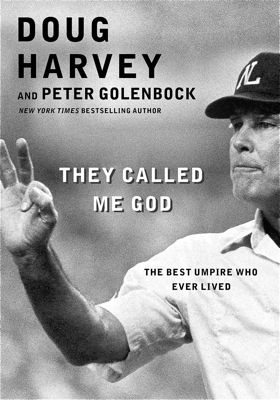
This example of Kzone is what governs the strike zone in higher levels of contemporary baseball. In reality, it’s not nearly this big. And there are consequences. (Press Pros File Photos)
The people who invented K Zone and Trackman never thought this through. When you leave pitchers no other choice but to throw the ball right down the middle…they find another way to compete.
 No one is claiming what happened to Jonathan India Sunday was intentional – Cleveland Guardians’ closer Emmanuel Clase hitting former Reds second baseman Jonathan India in the face Sunday with a 99 mile-per-hour fastball.
No one is claiming what happened to Jonathan India Sunday was intentional – Cleveland Guardians’ closer Emmanuel Clase hitting former Reds second baseman Jonathan India in the face Sunday with a 99 mile-per-hour fastball.
This, while nearly every administrative model in contemporary sports preaches safety, sportsmanship, and character in competition. No one liked what happened to India, nor should they. 100 mph to the head is a dangerous consequence of playing baseball in today’s world. But it happens, whether anyone can prove intent, or not. And here’s one reason why.
Over the weekend we received some response for questioning the strike zone of Big Ten umpire Daniel Jimenez during last Friday’s Ohio State-Oregon game at Bill Davis Stadium.

Publisher Sonny Fulks writes OHSAA sports and the Buckeyes for Press Pros Magazine.
 I wrote: “Plate umpire Daniel Jimenez, who’s never seen a borderline pitch yet he wanted to call a strike, thought differently, in the name of umpires’ big brother…’Trackman’. “ This came after a series of close pitches by Ohio State’s Drew Erdmann were called balls, off the plate, forcing Erdmann to throw the ball over the middle of the plate to Oregon’s Maddox Moloney, who waiting on it, hit it about 420 feet out of the park. It was one of five home runs that Moloney hit during the weekend series.
I wrote: “Plate umpire Daniel Jimenez, who’s never seen a borderline pitch yet he wanted to call a strike, thought differently, in the name of umpires’ big brother…’Trackman’. “ This came after a series of close pitches by Ohio State’s Drew Erdmann were called balls, off the plate, forcing Erdmann to throw the ball over the middle of the plate to Oregon’s Maddox Moloney, who waiting on it, hit it about 420 feet out of the park. It was one of five home runs that Moloney hit during the weekend series.
The response, from at least one reader, was that being critical of officials is a poor example to young players – lack of respect for authority, more or less. It hurts the integrity of the game. He went on to remind me that without umpires we could not play baseball, a frequently-heard lament today by governing bodies throughout amateur sports.
And I don’t disagree. I umpired college and minor league baseball for years and agree that respect for authority on the court and on the field is primary to character and a show of sportsmanship.
But back to the statement…”without umpires we could not play baseball, at all.” Really? So if that’s the case, why do we have technology like ‘K-Zone’ in the major leagues, and ‘Trackman’ in college baseball, dictating ball and strike accuracy to the point that if umpires grade poorly on working the plate during the regular season they won’t get tournament assignments in the post-season?
At least that’s what those being honest will tell you if you ask…because college baseball pays well. Very well, and more than your average laborer makes in a year.
So, why is it so important that the strike zone in today’s baseball be so restricted…compared to the days when I umpired in the minor leagues?
At the major league level the justification is that those who buy tickets want to see more offense – that no one pays $125 for good seats to watch a 1-0 shutout. Restrict the strike zone and you force pitchers to throw the ball in areas of the zone that are easier to reach – easier to hit. Therefore, more offense.
In the college game, coaches like Bill Mosiello blanched over expansion of the zone because he coached hitting. College hitters are less experienced, or less talented to hit high velocity in many cases, and a wider zone is an unfair advantage for college pitchers. And many, like Emmanuel Class, can throw 98 miles per hour.
On the other hand, college and high school pitchers are not as talented, or that accurate as to throw to a smaller strike zone. And because of that there’s more walks, lagging pace of play…and frustration.
And, today’s hitters stand on top of home plate in order to cover the entire zone, because the smaller zone limits pitchers’ ability to find a place to throw to that a hitter can’t reach. At the higher levels of baseball (even in college) pitchers throw inside in an effort to defend themselves. And sometimes, the consequences of the smaller strike zone aren’t so pretty.

At 6’5″ and over 300 pounds, McSherry was recognized as one of MLB’s biggest, and most trusted umpires.
In the professional game careers are on the line, millions in player contracts are on the line, along with egos and pride.
In the college game, the game itself is on the line because young pitchers are seldom experienced enough to throw the ball in a shoe box. College games are routinely three hours long, boring to watch, and hard to market to the paying public. Frankly, any amateur game is better when you call more strikes. Hitters are forced to swing. More swings produce more plays in the field, a faster pace of play, increased player confidence…and games a half hour shorter.
But yes, accidents happen.
Call fewer strikes and the emotions that come with competition affect amateurs the same as professionals. If you give up back-to-back home runs, like OSU’s Drew Erdmann did on Friday, you want to – need to – throw inside to intimidate. It’s part of the game – competing – and that’s just being honest.
You force hitters to respect you. And when that happens, pitchers are more effective, tempers don’t get out of control, the pace of play picks up, and it becomes a better game.

The best there ever was – Doug Harvey – said it’s a better game when you call more strikes.
Everyone who’s played the game knows this. But somehow, stupidly – stubbornly – we demand a smaller, more accurate strike zone, and for what? More offense, fairness, and respect for the written rules of the game and its 17-inch plate, written 150 years ago? That’s ironic in 2025, because we don’t respect anything else that archaic!
I’ll conclude by adding that during my time umpiring I spent more than a little time around major league umpires like John McSherry and Doug Harvey. During off-days in the minors my Double A partner and I would catch Braves games in Atlanta and afterwards hang out and learn from those guys.
Harvey had the reputation for being the best there ever was. Players and managers alike called him ‘God’, because he was so trusted…or at least that’s what they said. And this is what Doug Harvey said about the strike zone.
“The strike zone is to be interpreted, because every umpire is going to be a little different. If Greg Maddux is throwing within a ball width off the plate, doing it consistently, and you don’t call that pitch a strike, you’re going to miss the late news. Call it a strike and let the players adjust. Call it a strike and have a better game.”
McSherry once said, “The idea is to manage the game, not f— around with home plate. They’ll know what the strike zone is by the second inning.”
In all those years I never heard anyone say they were afraid of missing a pitch. They just wanted respect for their ability to manage the game – a game not dictated by ‘K-Zone’.
“The best there ever was”….would have puked at the suggestion.

The Dave Arbogast family of dealerships is the official transportation source for Press Pros Magazine.com.
